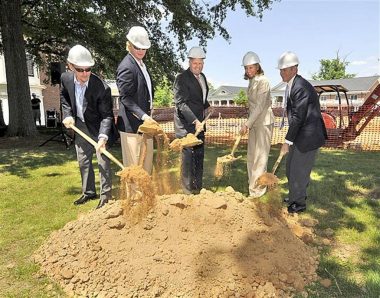A groundbreaking for Lindner Hall was held May 21 with the building’s family namesake and dozens of spectators present for the ceremonial start of what will be the “greenest” facility on campus.

Their son, Christopher, a business administration major, attends Elon. Another son – Carl IV – joined his parents and younger brother for the ceremony. Two other children were not able to attend.
“God has blessed our family, and through our faith in Jesus Christ, we really want to be a light and share with others, and give to institutions,” Carl Lindner said. “We’re really excited to be involved with this signature building.”
University President Leo M. Lambert thanked the Lindners for their support and talked about the future of the Academic Village. Once complete, he said, it will be among the most beautiful “Quadrangles” at any school in the nation.
“Carl and Martha,” he said, “we are just thrilled and indebted to you for your graciousness, your generosity and your tremendous support.”
The building at Elon will be the new administrative home of Elon College, the College of Arts and Sciences, and the home of the history and geography, and the sociology and anthropology departments. Blueprints call for a spacious first-floor reading room, high-tech classrooms, a computer lab, faculty offices and space for student-faculty mentoring.
Environmental sustainability is a key component in both the construction and operation of the building. Seventy-five percent of construction waste will be recycled, much of the building will be made of steel and tile that contain recycled material, and photovoltaic solar power cells will help generate power on site, among other features.
An estimated 8-10 percent of all power consumed by the building will be generated by those solar power cells and by solar energy used to heat water.
Lambert described the groundbreaking as “ceremonial,” which sparked laughs from the crowd, since construction equipment and a dirt lot served as a backdrop to the ceremony.
Work crews first broke ground at the site in late April.


